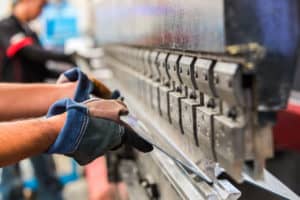Math is at the heart of sheet metal bending. As a sheet metal company, we often use different calculations and formulas to determine how much we can bend, shape and change our products. Of these several calculations, one that we constantly rely on is the k-factor.
The k-factor of metal is the ratio of the neutral axis to the thickness of the material. If you already understand the relationship between these two variables, then this is likely straightforward information. However, if you would like our sheet metal company to expound on this further, continue reading below.

What Is the Neutral Axis?
One of the most essential concepts to understand at a sheet metal company is the nature of bending metal and other materials. When a bend occurs, two opposing processes occur simultaneously. The inside portion of the bent area compresses while the outside portion expands. In between these two portions of the material is the neutral axis, where neither compression nor expansion occurs.
What Affects the Neutral Axis?
Different metal bending processes, like air bending, bottoming and coining, affect the metal differently. The hardness of the material will also affect the neutral axis, with harder materials generally having a larger k-factor. A final factor to consider is the radius, or severity, of the bend. A sharper bend runs the risk of creasing the material.
Why Does Knowing the K-factor Matter?
When you ignore the k-factor of sheet metal, you increase the risk of breaking the material through creasing. Even if you don’t entirely break the material with the bend, a crease in the centre of a bend amplifies variations in the grain direction, hardness, thickness and tensile strength of the material. As a result, incorporating it into your calculations is essential to proper metal bending and forming techniques.
Is the K-factor the Only Consideration When Bending or Shaping Metal?
Absolutely not. There are several factors that go into determining the best way to shape and bend metal. Not least among these is the grain of the metal, which will either help or hinder the bending process. This is dependent on the grain’s orientation to the bend. Still, this is not the only consideration for those professionals who work with these tools and equipment.
Another consideration where it concerns bending metals is the metal itself. Different metals have different amounts of malleability, softness and other qualities. These qualities can all affect the bending process and calculations necessary to make successful bends.

Recent Comments